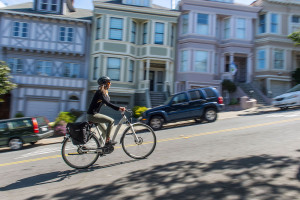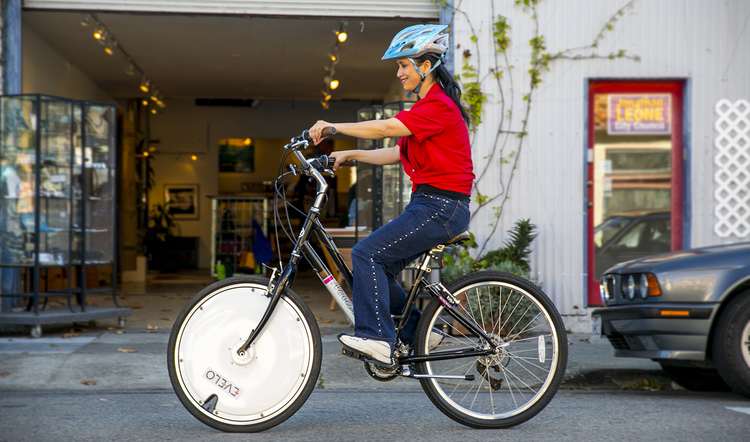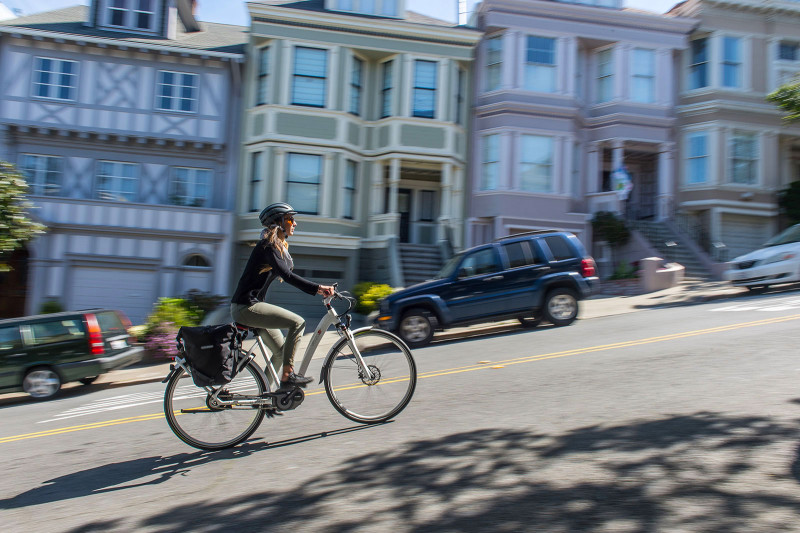How to Start Commuting on an Electric Bike – The Gear – Part 2

Now, on to your gear:
There’s a fair bit to cover here. How should your bike be equipped? What do you need for clothing? How will you carry it and other cargo? What about mechanical malfunctions?
As far as equipment, there’s a number of things to consider.
First, how to carry your cargo? I recommend that at least you have a good rack and bag to carry your clothing, papers/laptop and repair kit.
In general, I prefer to carry weight on the bike and not on myself. This is a personal preference, and you may find that a backpack or courier bag works for you. I do actually have a backpack as my “briefcase” or “handbag”, but I find I prefer not riding with it on me, so I usually strap it to the top of my rack with a bungee net instead of wearing it.
If, as many of us do, you need to carry a laptop, there are backpacks designed specifically for doing this. Just make sure to pad fragile items well. This is also where your clothes are, so you can use them as padding. Finally this is where your repair kit goes – and you must have it!
Now, you may want to ride to work in your cycling clothes, and then change once you get there. This doesn’t necessarily mean special bike clothing. Maybe just a tee-shirt and shorts or sweatpants. Whatever is comfortable for you. And even this may be overkill for you. If your ride to work is short, you may not even need to dress differently at all for the ride.
For example: the Dutch ride everywhere in their everyday clothing all the time. The only time they put on special bike clothes for longer recreational rides. This is common anywhere cycling is a popular mode of transportation. I do it myself if the ride is under 5-6 miles, and it’s not too hot/cold/rainy outside.
Some people, for example, those who must wear formal attire at work, often drive one day a week. You bring in a full week’s worth of clothing on that day, and bring home each day’s dirty laundry on each ride home.
This can be useful if you need to wear a suit and tie or dress to work, and don’t want it to get wrinkled while stuffed in a bike bag. If you do need to carry formal clothing, remember that rolling is better than folding for preventing wrinkles.
You also need to be prepared for breakdowns and bad weather.
On the EVELO blog, I have 2 articles: one on repair kits, and the other on my favorite bike multi-tool which I would suggest you read.
The first one discusses what you should carry to make repairs on the side of the road and the other is a specific recommendation for a multi-tool, which is indispensable for the serious rider: Take a look here: What To Carry In Your Basic Bike Repair Kit and Be Prepared with an AliEN Multi-Tool.
Here’s another thing: make your bike less likely to get flats! That’s the primary thing that goes wrong on a bike, and there are ways to make this less frequent. Two of them are thorn-resistant tubes, and Kevlar lined tires. Again, I’ve written a blog post about the tubes: Keep Riding With Thorn Resistant Tubes.
Maintain your bike well, as you would your car. It’s much more pleasant to work on your bike at home, or to bring it to a shop than it is to have to fix it on the side of the road. A little preventative maintenance will pay big dividends. Don’t let little issues pile up – fix things as soon as you can. Your bike will both be more reliable and nicer to ride.
You should also consider having rain gear in case the weather goes bad on you. Fenders are a good idea as well – they help keep you and your bike cleaner. That’s both more pleasant for you, and it will reduce maintenance on your bike. Even if you aren’t planning to ride in bad weather, it sill is nice to be prepared in case it should happen.
I ride year round, and will be writing a blog soon on how to equip yourself and your bike to do this. There’s a saying among those who spend lots of time in the outdoors, which is “There is no such thing as bad weather, merely bad clothing”.
As your mother might have said when you were a kid: “go outside and play – it’s just a little rain – you aren’t made of sugar and you won’t melt!” In fact, if the weather is warm enough, riding in the rain can be very pleasant and enjoyable. Plus, then you don’t have to take a shower after the ride 😉
You also need good lighting. Many electric bikes come with built-in lights, but if yours doesn’t, or you are riding a non-electric bike, make sure to have these. Even if you aren’t planning to ride after dark, you should be prepared, just in case.
LED based lights are cheap, bright and run for a long time on a set of batteries, so there’s no good reason not to have them. They don’t just make it easier for you to see, but they make you more visible as well. Visibility to others = safety.
Finally, there’s the ultimate option – roadside assistance. Velosurance offers roadside assistance in addition to full insurance coverage for your electric bike that many homeowner/renter insurance policies won’t cover.
Regardless, if you are going to ride for transportation, where you need to be places and can’t just end your ride if something goes wrong, you need to be prepared with the tools and knowledge to fix your bike and keep yourself warm, dry and safe.
A few final notes: Don’t think that just because you can’t commute by bike every day that it isn’t for you. Start slowly and work your way up! Maybe 1 or 2 days a week in the beginning is all that you’re up for. The point is to get over the “it’s too hard” hump and learn what works for you, at a pace that you are comfortable with.
You’ll soon find it becomes routine and you’re comfortable riding even more. When you first learned to drive, the experience was probably quite daunting, but you got used to it. Bicycling for practical purposes is the same way.
What about if you have an emergency at home and you need to get there right away? Many companies have a “guaranteed ride home” program for people who use bicycles or public transit, as a way to encourage more people to commute this way.
They do this for a variety of reasons, but one is because the Federal government, and some state governments have incentives in place for companies to reduce their impact on traffic. What this usually means is that they’ll reimburse you for a taxi ride if necessary.
Your company may also reimburse you for certain commuting expenses, such as maintenance on your bike and gear to make commuting feasible. Again, this is often due to government incentives. Ask your HR department if this is something your company does.
And remember, there’s no shame in skipping a day or 2 or 5! If the weather is nasty, or you are tired or injured, don’t ride. This is about making your life easier, more fun and more enjoyable, not harder.
If you have the option to drive, or work from home when the conditions aren’t good for riding, take advantage of that. To quote Jerry Greenfield, President and Co-founder of Ben and Jerry’s Ice Cream: “It it’s not fun, why do it?”
Enjoy!
Written by David Rodenhiser. David is the Customer Service Manager and Resident Blogger at EVELO Electric Bicycle company. When he’s not busy helping folks find the perfect electric bike for themselves, he writers a weekly blog column where he presents the best bike accessory reviews, useful apps for casual riders, and other tips for electric bike riders.
P.S. Don’t forget to join the Electric Bike Report community for updates from the electric bike world, plus ebike riding and maintenance tips!








[…] Now checkout Part 2 for tips on the proper bike commuting gear and maintenance! […]